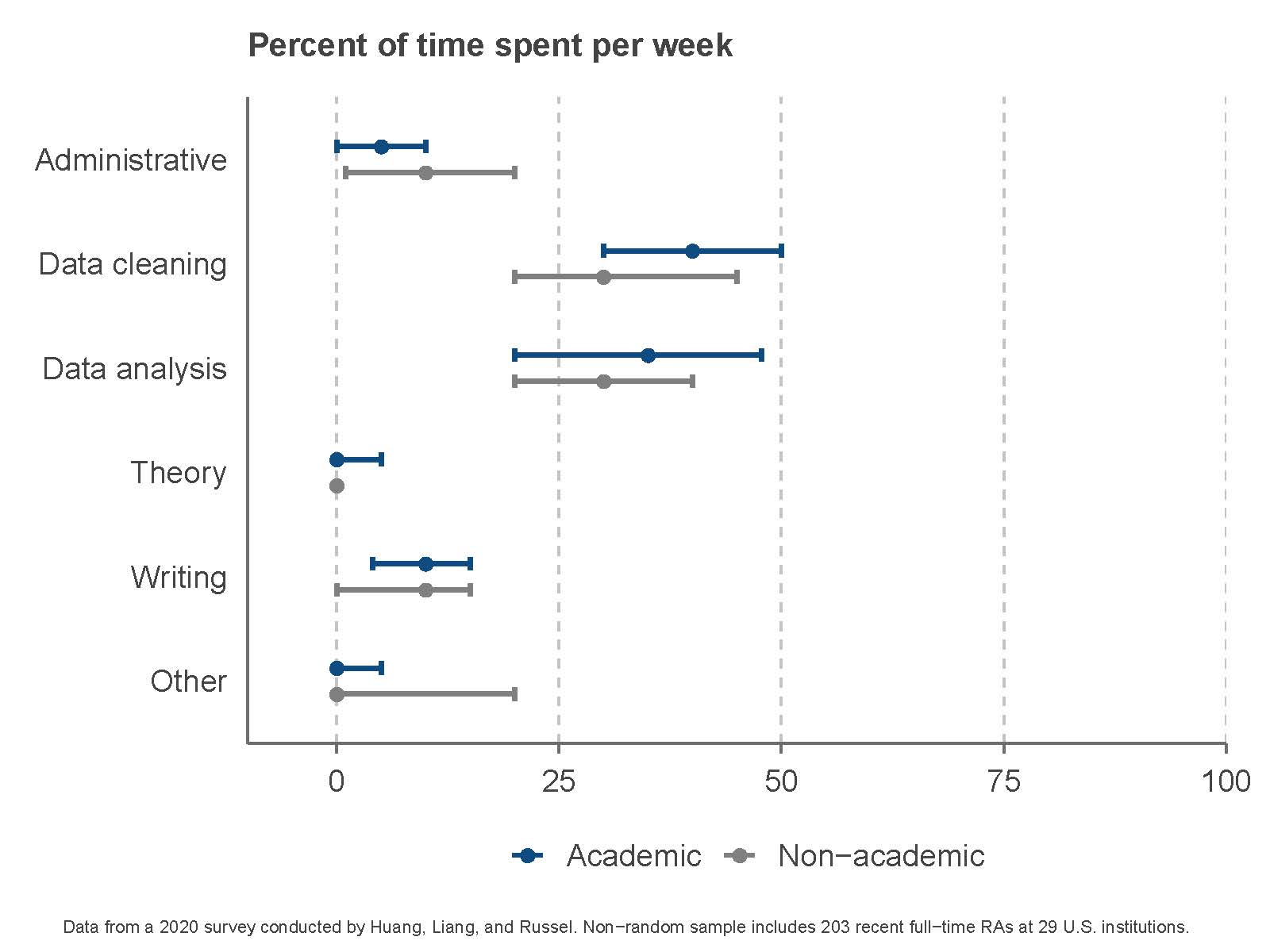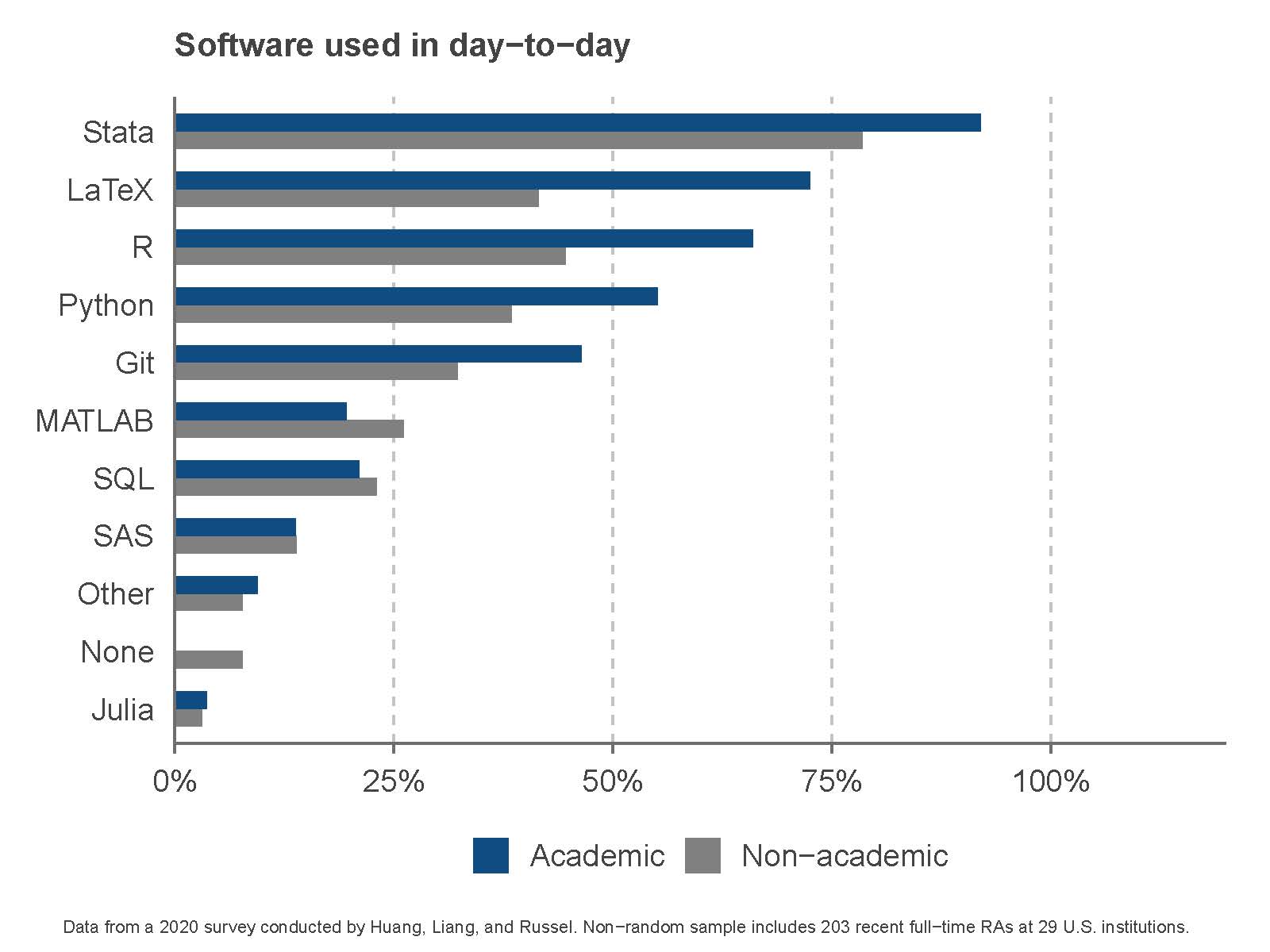What do RAs do?
This will vary widely across positions, but you can pretty much count on doing a lot of “data management” - that is, gathering, cleaning, and analyzing data - wherever you end up. You may also do some administrative work and other miscellaneous tasks, such as writing grant applications, designing questionnaires, or communicating with partner organizations.

RAs use a wide variety of technical tools, though the most common softwares are Stata, LaTeX, and R. In the RA survey, patterns of use look somewhat different between academic and non-academic institutions.

A day in the life of an RA
Your day-to-day experience can vary a lot by type of institution or project stage. Below, we list some examples of what day-to-day life might look like for an RA in an academic setting, on a development project, or at the Federal Reserve.
Working at a university
RAs at universities often work on academic papers. The nature of the work can depend on the stage the paper is in, from exploratory analyses and literature reviews to submission and publication.
1. Early stage of a paper
In the early stages of a project, you may spend time collecting and cleaning data, helping draft grant applications, and conducting exploratory analyses in e.g. Stata. A day-in-the-life might start with downloading data files your PI(s) requested, cleaning the data using Stata, and producing some quick summary statistics tables that highlight anomalies in the data (e.g. missing observations for an important outcome variable). In the afternoon, you might have a call with your PI(s) to discuss the tables you produced, at which point they might suggest you look into whether related papers had similar issues. You might then spend an hour or two buffing up a literature review and reshaping the dataset to accommodate the analyses the PI suggested you explore for your next meeting.
2. Middle stage of a paper
At the middle stage of a paper, your PI(s) may already have a tentative set of results in the form of tables and figures or an early draft of the paper. Aside from the regular interactions like meetings with your PI(s) or with other RAs, your daily tasks could involve cleaning and processing data, formatting tables in LaTeX, or conducting new analyses. Your PI(s) may be giving presentations at other institutions to get feedback on the paper, in which case you may spend some days drafting presentation slides.
3. Late stage of a paper
Working on the later stages of a paper involves either preparing the paper for submission to a journal or revising and resubmitting the paper (R&R) for publication. If you are preparing the paper for submission, you may be completing tasks such as building replication files or finalizing tables for publication. If you are working on an R&R, your day might start with editing language, incorporating feedback from a referee report, or formatting the paper in LaTeX. After attending a seminar, you might spend the afternoon running extra robustness checks or generating alternative specifications of a main figure for the appendix.
Working on a development project or experiment
The nature of the work will be largely determined by the phase of the project.
1. In the survey piloting phase
The role of the office-based RA during this phase is to help write and administer a prototype of the survey that will eventually be used for data collection. During this phase, most days will involve helping your PIs draft survey questionnaires and helping the field team (including field-based RAs and managers) design, program, and roll out the pilot survey. This may entail a visit to the field (i.e. the region where the study is based) to actively support the field team in piloting the survey and modify it as necessary.
2. In the data collection phase
The role of office-based RA during this phase is to help “process” (check for anomalies, formatting, etc.) and maintain the quality of the incoming data. Most days will involve cleaning and processing survey data from the previous day, and staying in contact with field-based RAs and surveyors who are calling or visiting households to administer surveys. This may entail a visit to the field, where working directly with field-based RAs can help you quickly understand patterns, anomalies, and data entry quirks in the data. You may have regular calls with PIs to update them on field operations.
3. In the data analysis phase
This phase typically overlaps with the data collection phase, meaning the role of the office-based RA is to help process and maintain the quality of the incoming data but also to start data analysis on what’s available. A typical day might look as follows. In the morning, you may have daily calls with field-based RAs to update each other and help clean data from the previous day. In the afternoon, you may be reshaping data to produce a new set of tables for the next weekly call with senior PIs, while messaging/having short calls with junior PIs to discuss the results throughout the day.
Working at the Federal Reserve
An average day
Just as in academic RAships, you may spend most of the day cleaning or analyzing data, typically in Stata or Matlab. However, unlike academic RAships, RAs at the Fed are more likely to work on policy-oriented work in addition to academic work, a distinction that may require switching between computers throughout the day for data security purposes. You are typically paired with one or two economists and you might meet with them some days, but most days may be spent on your own or with another RA otherwise. During lunch, you might go to lunch seminars or eat in the Fed cafeteria. During the afternoon, you might take a break to grab a coffee with other RAs.
Before a Federal Open Market Committee (FOMC) meeting
Every 8 weeks, RAs and everyone else at the Fed drop all research and switch to preparing data and figures on economic indicators for the meeting. Your set of tasks will look similar to those of an average day (above), but the work will likely go at a much faster pace.